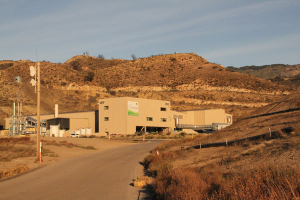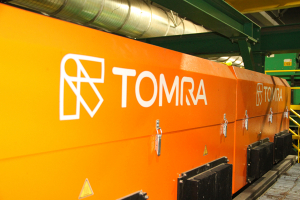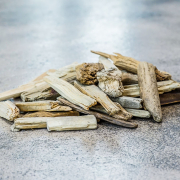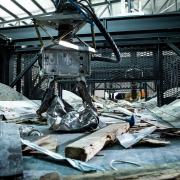Mixed Waste Processing with Tomra Autosort
Santa Barbara County’s Resource Center sorts municipal solid waste (MSW) and single stream using the same circuit with the sorting technology realized in the Tomra Autosort.
Santa Barbara County’s Resource Center in California may be a model of efficiency for future material recovery facilities (MRF) in North America. Conceptualized roughly 20 years ago, the mixed waste processing facility at the Tajiguas landfill site, in operation since 2020, is designed to meet the state’s stringent organics recycling diversion targets set for 2025. Plus, it recovers recyclable commodities from municipal solid waste that would have been landfilled just a couple of years ago. According to Wilfred Poiesz, recycling system design and sales manager for the MRF builder Van Dyk Recycling Solutions (Norwalk, Connecticut), it runs both MSW and single stream on the same circuit.
A green solution for organics
Dubbed the biggest change to happen in waste management in over 30 years, California’s Senate Bill (SB) 1383 targets organic waste to reduce short-lived climate pollutants in the state. It requires the state to reduce 75 percent of organic wastes – food, green waste, paper products, among others – by 2025. In 2018, California disposed of approximately 24 million tons of organic waste, and the mandate targets to reduce this by more than 20 million tons by 2025.
The recovery facility’s design was – in part – geared toward meeting those mandates. The Tajiguas landfill serves the South Coast and the Santa Ynez and New Cuyama Valleys’ commercial and residential waste services. “We serve approximately 220,000 people,” Carlyle Johnston, project leader at the County of Santa Barbara, was cited. “Santa Barbara is an affluent county, and the general rule is waste generation increases with affluence.” Waste generation for county residents would average nine pounds per person (about 4,1 kilograms/person).
The facility first shreds MSW to break apart and resize materials before being processed. The automated circuit handles material between 2.5-14 inches (1 inch = 2.54 cm). Then a series of trommels and screens sizes the material. Any heavy material falling through the 2.5-inch screens is treated as organics and sent to the anaerobic digesters. It is converted into compost and biogas for electricity.
Profiting from commodity recovery
With 20,000 square feet (about 6,096 square meters) under the roof for tipping floor space, Alan Coulter, general manager for MarBorg Recovery, operator of the Resource Center’s MRF, says space is tight. “We can’t keep material sitting on the floor for too long. We must keep it flowing from the floor to the circuit.” The automated sorting circuit’s designed capacity is 1,000 tons per day. The screening process also separates oversized material greater than 14 inch, diverted from the automated circuit for manual sorting. “Our goal is for quantity of material removed from the stream, so we employ manual sorters to help maximize material recovery.” The remaining 2.5- to 14-inch waste material is sent through a series of ten Tomra Autosort units for recovering recyclable commodities, including plastics, plastic film, paper and wood.
Compact and flexible, the Tomra Autosort multifunctional sorting system can be used across different material sorting applications, including MSW, single stream, plastics, and e-scrap. As reported, the new generation of the sorting system incorporates the latest Tomra technologies to offer advanced accuracy of complex sorting tasks, such as pulling recyclate from MSW feed material, at high throughput rates.
“Using near-infrared (NIR) and visible light spectroscopy (VIS) to identify objects, Autosort’s Sharp Eye technology increases light efficiency while maintaining the same energy consumption to advance sorting sharpness and improve separation of difficult-to-target fractions,” Tomra informed. The sorters would also include its patented Flying Beam sensing technology to offer better light efficiency, flexible and easy installation, and enhanced light signal efficiency for improved detection.
The Resource Center’s circuit is designed to use a positive sort, where the desired recyclable material fractions are ejected by the valve blocks, to increase recovered material purity. Each sorting unit is equipped with three to four different “recipes” of materials that operators can select to recover from the unit. “Autosort can be configured with dozens of recipes for recovered materials,” Parker Bynum, sales manager for Tomra Recycling Sorting, gave account. “Tomra collaborated with Van Dyk to configure the sorters according to the customer’s needs.”
Quick switch to single stream
MarBorg runs MSW through the automated sorting circuit throughout the day to sort single stream recyclable material during the second shift. The circuit only shuts down for approximately 30-45 minutes to allow workers time to clean the screens and change Autosort’s recipes to single stream sorting.
When running a single stream, workers increase the speed of the feed material conveyor belt through the circuit. Currently, the facility sorts and recovers five different spec recyclable plastic products, cardboard, aluminum and paper. The recovered recyclable material helps to defray the Resource Center’s annual operating costs. The recovered products generate approximately six million US-Dollar in sales annually, Johnston informed. Although the facility is not self-sustaining, it would lower the facility’s operating costs.
More importantly, the Resource Center is achieving its goal of diverting material from landfill. That extends the life of the Tajiguas landfill and puts off the need to expand or site another landfill. “Between sorting MSW and single stream, our goal is achieving a diversion rate of approximately 80 percent,” Coulter underlined.
Also, to comply with a portion of California SB 1383, the Resource Center has created an Education Center, where they open the facility to groups ranging from school-age students to senior citizens. Each year, the facility sees more than 1,000 visitors tour the Education Center to learn more about waste and recycling.
(Published in GLOBAL RECYCLING Magazine 1/2023, Page 16, Photo: Tomra)











